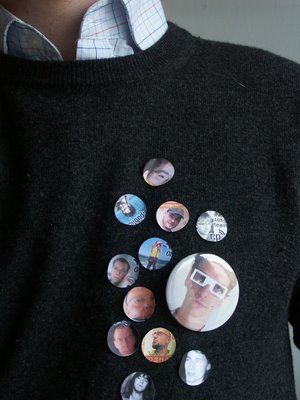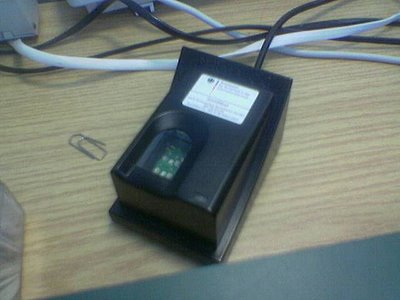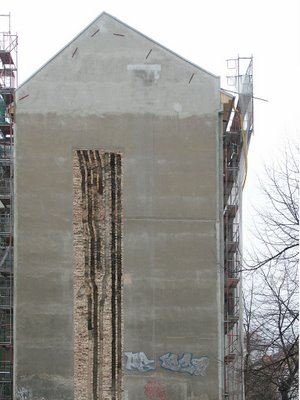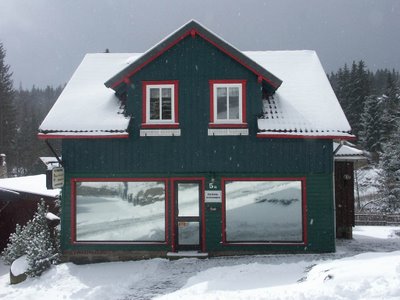Archive for March, 2008
“Follow me!” project for re:publica

I am preparing a nice little intervention for the german blogger conference re:publica 2.4.-4.4.2008, Kalkscheune, Berlin. Twitter community and all other microblogging users will have the opportunity to wear their profile picture/logo as a button badge. Show your web identity in real life! With small stickers of the same logo users can mark each other as followers on T-shirts/pullovers/laptops.
“Ah, it s you! What’s your nickname again?”
“How many followers do you have? Look at mine!”
I hope it’s going to be fun. More details and thoughts on this group-performance/conference- intervention in german. [To be translated soon.]
update: pic changed
Follow me!
Zeig dich mit deinem Twitterlogo auf der re:publica Konferenz! Sammel jede Menge follower und lass sehen wen du alles kennst!
„Kennen wir uns nicht von Twitter?“
„Ach, Du bist das! Wie ist nochmal dein Nickname?“
„Hattest du nicht letztens noch ein anderes Profilfoto?“
„Und? Wieviel follower hast du schon?“
„Sind die colorwars nicht endlich vorbei?“
„Wo ist Kosmar? Ah, da läuft der rote Besen…“
Das Projekt „Follow me!“ ist eine soziale Intervention und Gruppen-Performance für Konferenzen und Events rund ums Web. In Anlehnung an Microbloggingdienste wie Twitter, Jaiku oder Pownce interagieren die Teilnehmer des Projektes untereinander mit den Symbolen und in den Regeln dieser Social Web Services im realen Raum.
Jeder Teilnehmer bekommt einen Anstecker und mehrere Aufklebern seines Twitter (o.ä.) Profilfotos/-logos. Der Button wird am Hemd/T-Shirt/Pullover getragen und ermöglicht anderen Konferenzteilnehmern „Twitterfreunde“ wieder zu erkennen. Mit den kleinen Profilaufklebern können sich die User dann gegenseitig als Follower/Freunde auf dem T-Shirt „eintragen“. Ganz im Stile von Twitter entsteht ein grosses Wer-Followed-Wen-Spektakel mit jeder Menge face-to-face Interaktion.
Ein wichtiges Element bei allen Social Web Plattformen, insbesondere aber bei den Microbloggingdiensten ist das Profilogo des Users. Das Profilfoto, welches normalerweise ein Portrait des Nutzers zeigt avanciert zum quasi Markenzeichen des Users. Bei der Nutzung von Twitter und Co. erscheint zu jeder Kurznachricht eines Users das jeweilige Profilfoto im Webinterface. Da die User sich nicht unbedingt persönlich kennen, nimmt das wiederkehrende Bild, in Verbindung mit den geschriebenen Nachrichten eine zentrale Funktion als Interpretations- und Projektionsfläche ein. Auf diesem schmalen Kanal der Kommunikation entsteht ein Netzwerk von Bekanntschaften, die auf digitaler Ebene eine reale Verbindung eingehen.
Wie beeinflusst das Social Web Beziehungen zwischen den Menschen? Auf welcher Ebene, der digitalen oder der physischen lernen sich die Menschen wie kennen? Wie stellen sich User im Netz dar und wie werden sie dort wahrgenommen?
Aram Bartholl 2008
Fingerprint

There was a long dicussion on finger print scans for passports in germany. Eventually the government introduced them last Autum. This is the official german passport fingerprint scanner at Berlin Mitte “Bürgeramt” administration I saw yesterday.
… No, not yet. My old passport is still valid till 2009. But USA has already a scan of my fingers … strange.
Walking Ladder
The International Dance Party post has been so successful since Jonah picked up for the MAKEblog I just have to show another vid of Niklas. The walking ledder is one piece of a series Niklas did during a workshop week in *.artlabs in Sibiu, Romania lately. I like the switch best. :-)
Chimney
“Re: Mirror test”
I met Christian some years ago during a conference on location based services “The Story of mobile Experience” in munich. Since then we had a lot of interesting conversations because we both work/worked in mobile/web-business and in art. Christian Wiener and Stefan Plessner a.k.a www.meshes.org did a nice series of works and installations in the field of mobile computing and image recognition. Beside “Re: Mirrir test” I also do like the voice tag project (video) a lot.
Re: Spiegeltest from meshes on Vimeo.
The installation entitled Re: Spiegeltest (Re: Mirror test) looks very simple at first glance. An elongated box positioned openly in the room is affixed with a mirror at each end. The mirrors are manipulated in such a way that the mirror image of the viewer is superimposed over a projection of a second image, a digital portrait, which comes from the inside of the box. Together, the two create digitally exaggerated phantom images. Like the distorted images in chambers of mirrors, these phantom images also have an ambivalent effect. The viewer is initially incredulous and irritated, yet he also goes along playfully with the fascinating offer of a new interpretation. He attempts at first to recognize the familiar mirror image, the visual expression of his individual self. In a chain of comparative reflections, he also explores the new and different in a gradual process. … continue
Mirror House
Mac Icon Watch
![]()
I wonder if this watch really shows the time. On old mac OS this icon was the classic waiting symbol. But the pointers spin much faster than on a real clock. Would be nice if they did this here too.
;-)
“International Dance Party”
Good friend Niklas has a nice new project online. I like the video! Let’s go for a beer this week, Niklas.
International Dance Party! The full length video of this crazy and funny party machine! from Niklas Roy on Vimeo.
internationaldanceparty.com
myspace.com/internationaldanceparty
The interactive machine International Dance Party is a complete plug ‘n’ play party in a box.
The machine comes as a large, non-suspicious looking flightcase. Internally, it is equipped with cutting edge radar sensing technology, an ear blasting state of the art 600W sound system, tons of psychedelic light and laser effects, and even a professional grade fog machine.
Through its dance activity radar, the International Dance Party detects and evaluates motion input from surrounding people in realtime. Several sophisticated transforming mechanisms let the flightcase turn into a powerful and boosting party machine, once the visitors start to dance within the machine’s range of perception.
The audience controls the complexity of the generated music and the intensity of the light effects directly by the energy of its dance action. When there is no audience, or when the audience is not active enough, the machine stops its performance and transforms back into a transport crate.
Ripsaw in Cologne
And here is the interview (german) at Giga TV introducing “1H” I posted about lately.
Interview: Aram Bartholl at Giga.de from Aram Bartholl on Vimeo.
Happy easter!
I’ll be a week on early easter holiday. Have a good time!

